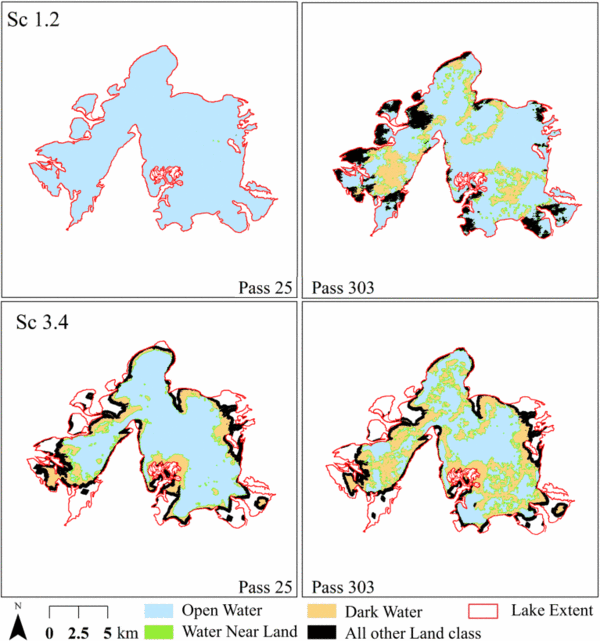Swot and the vegetation around and within lakes
Image of the Month - March 2022
Most lakes and water bodies are surrounded by vegetation, and can also have vegetation within the waters. Ka-band, which is the frequency of Swot Kar-In altimeter-interferometer has been shown to be sensitive to vegetation. In preparation for Swot, a Canadian-French team examined the impact of vegetation on Swot measurements, to estimate whether the Water Surface Elevation and/or the Water Extent retrieved from Swot can be affected, or not.
We already mentionned Lake Mamawi (Alberta, Canada), a shallow water lake surrounded by vegetation. An AirSwot campaign, the plane-based instrument prefiguring Swot altimeter-interferometer, was led in the region, and Swot data simulations of the area have also been computed.
The study compares vegetation data from AirSwot campaign, Radarsat-2 SAR and the simulations computed from different vegetation hypotheses (none, aquatic-only, aquatic and emergent riparian vegetation, with different hypothesis for the latter two). This enabled to conclude that aquatic vegetation should have little effect on the water detection and water surface elevation estimation capabilities of Swot. However, emergent riparian vegetation could be a concern for water classification (and thus water extent estimates and water storage), especially in very wet environments. The use of ancillary data such as SAR to provide with a "vegetation flag" could prove useful in water classification.
Swot launch is approaching, and all the teams involved in the Science Team are getting ready. Studies looking at all aspects of the measurements and itheir corrections are developed, so as to make the most of the data as soon as they are available.
See also:
- Image of the Month, June 2021: Swot and the lakes' winds
- Applications / hydrology: lakes and enclosed seas
- Applications: High-resolution hydrology
- Missions: Swot
Reference:
- Nicolas M. Desrochers , Mélanie Trudel, Sylvain Biancamaria , Gabriela Siles, Damien Desroches,
Denis Carbonne, and Robert Leconte, 2021: Effects of Aquatic and Emergent Riparian Vegetation on SWOT Mission Capability in Detecting Surface Water Extent, IEEE Journal of Selected Topics in Applied Earth Observations and Remote Sensing, VOL. 14, pp 12467 - 12478, https://doi.org/10.1109/JSTARS.2021.3128133





